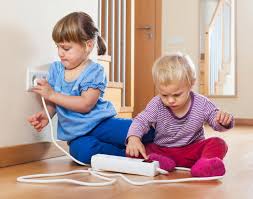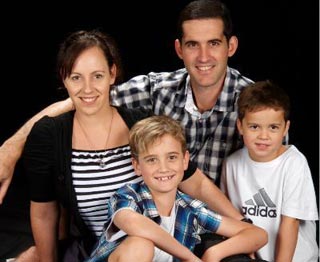Children aged 2 to 5
Children of this age group are the real ‘explorers’ and constantly active. Make sure their environment is safe to explore and keep them busy with lots of fun. It pays to make a plan or have ‘play cards’ on which you write down an activity and you can pick a card if you need inspiration.
It is nice if you can get together with other au pairs/nannies/mums who are looking after children of the same age. Ask the parents if you can take the child/children to play groups or music groups nearby or meet up at local playgrounds.
Here are some ideas to entertain children in this age group:
Tell them a story, either read from a book or make one up. And why not let them tell you the end!
Sing and dance – put on some music and dance together.
Arts & crafts, make ‘things’ from old cereal boxes, toilet rolls etc. cut pictures from magazines and stick them on a big sheet to make a collage. Color, paint, stick, etc.
Make a cake or cookies together
Play ‘follow the leader’ and take turns in ‘who copies who’
Make a ‘shop’ and sell boxes of cereal, packets of pasta and other simple items to each other
Go outside to the park or the beach – (ask mum where)
2 – 3 years physical development
With a toddler now much more physically able, he’ll want to explore the outer limits of his abilities. He’ll love to climb, jump and run – often in a direction opposite to you! But his new-found confidence will also mean that he is at a higher risk of accidents as he doesn’t understand when he should stop.
Developmental milestones include:
Developmental milestones include:
At 2 ½ years:
he can run smoothly
he can climb on and off play equipment
he can self-feed using a spoon and drink from a cup
he can softly kick a large ball, though often not in the intended direction
he can walk up stairs
he can throw a large ball in the intended direction
He can undress himself and is beginning to learn how to dress himself
By 3 years:
he can independently walk up and down stairs
he can pedal a ride-on toy such as a bike
he can balance and walk on tippy-toe
he can kick a ball with force
he can throw a ball, and attempt to catch one, with two hands
he has begun toilet training – although some toddlers won’t attempt it until they are close to 4 years
he can self-feed using a spoon and fork
What can I do to encourage his physical development?
Introduce toys for stacking, threading and pulling apart – blocks, simple jigsaws, beads (make sure that they are large enough that they won’t pose a choking threat) toy cars, animals and dolls.
Give him plenty of time to play outdoors – take him to the local park to play on the swings and slippery dip, or the beach to dig in the sand, or your garden for kicking a ball and water play
Allow him to explore his world, but remember that he doesn’t know how to keep himself safe.
FAQ – au pairs often indicate they are worried about handling ‘terrible twos’ because of tantrums; the following is very useful!
Every child will throw a tantrum at some point. But there are ways to deal with tantrum episodes and prevent them from happening again…
‘Toddler-proof’ the home by placing dangerous or breakable things out of reach.
Have clear routines to your child’s day, for example regular lunch, nap, bath and bedtimes.
Plan ahead, keeping an eye on frustration levels so you can step in before they go over the top.
Provide lots of opportunities to let off steam every day –running around outside, at the playground, dancing to music.
Give children some control and choice over what to eat, wear or play with.
Use distractions and diversions for as long as they work – a new toy, a changed activity, a song or game.
As children reach pre-school age, discuss how you want them to behave in different situations and have clear, simple rules.
If Tantrums do happen…
With all the previous strategies in place, parents are likely to have a relatively tantrum-free life. But it makes sense to have a few ideas up your sleeve for how to deal with them.
For a minor episode…
Try ignoring, by walking into another room or just carrying on with your own tasks
Use calming techniques to lower your own stress levels – deep breathing, relaxing your muscles, positive talk inside your head: ‘I will keep calm’.
If ignoring hasn’t worked, some children can be jollied along out of an episode. Say something like, ‘Time to stop now – I’ll count to 10’, and then give plenty of praise and cuddles if the tantrum stops.
In the supermarket, it is sometimes best to just pick up your child and go outside to cut down your embarrassment.
For a really major tantrum, different tactics are needed…
Speak calmly, saying things like ‘I’m here; I won’t let you hurt yourself’.
Hold your child tightly, preferably making eye contact.
Sometimes you just have to weather the storm till your child calms down.
‘Time out’ can help if you find it impossible to stay calm. Time out involves putting your child somewhere safe but boring (for example a playpen, pushchair or the bottom step) for a couple of minutes. It should never be forced in anger and is not really understood by under 3’s. It may work best for parents to take it themselves!
Top Tips for Cutting Down Tantrums
Aim for some happy, relaxed times every day – reading a story, visiting the park, playing a game.
Show a good example by remaining calm when times are stressful. This encourages your toddler to do the same.
Cut down negatives – constantly saying ‘No’ will add to a toddler’s frustration.
Instead, use phrases like ‘later’, or ‘after lunch’.
Keep aware of new stresses (potty training, starting nursery) that may need more sympathy.
Respect your child’s feelings. Feeling understood will reduce your child’s need for tantrums. Try saying, ‘I know that makes you mad’ or ‘That must have made you feel sad’. Your child will see that their feelings matter and can gradually learn to put them into words, saying “I’m angry” instead of acting it out.
Use positive parenting – plenty of praise and attention for behaviour you do want, trying to ignore as much as possible behaviour you don’t.
Avoid harsh discipline – shouting and punishments only make tantrums worse.
Use humour to defuse tricky situations – silly songs, laughter, making a game of tidying toys can all work brilliantly! A hug or a tickle at the right moment can also change a child’s mood.
Most children do grow out of the need for tantrums when they have more language and understanding. But the way you deal with them in the toddler years is important. If they are handled harshly, with responses like yelling and smacking, or if you constantly ignore their feelings and need for comfort, they may well become worse and carry on for longer.





